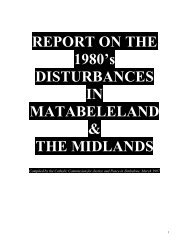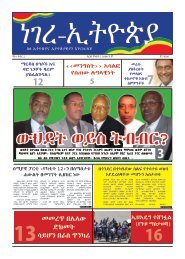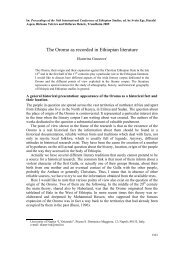Atlas Final Web Version 6_14
Atlas Final Web Version 6_14
Atlas Final Web Version 6_14
You also want an ePaper? Increase the reach of your titles
YUMPU automatically turns print PDFs into web optimized ePapers that Google loves.
Introduction<br />
Why an <strong>Atlas</strong> of Ethiopian Livelihoods?<br />
geography for the whole country seemed to call for an <strong>Atlas</strong>, as<br />
We begin with some basic geography, showing how<br />
Our understanding of rural livelihoods in Ethiopia has<br />
developed greatly over the last two decades. The challenge has<br />
come from information needs on both the emergency and the<br />
development sides, in the quest for better-founded decisions<br />
on action and investment. One relatively recent government<br />
initiative, assisted by USAID, has been to put livelihoods<br />
analysis at the center of Ethiopia’s official early warning system.<br />
one good way to share the results with interested people both<br />
in and beyond the sphere of early warning. Here we should<br />
pay tribute to the IFPRI <strong>Atlas</strong> of the Ethiopian Rural Economy 2 ,<br />
which prompted us to think of using the present, separate set<br />
of data to offer a quite different, but we hope complementary,<br />
production.<br />
The problem was how to select and shape data from this<br />
topography, altitude, rainfall, and population density come<br />
together to form the environments in which households<br />
live. The most basic division is between pastoralists,<br />
agropastoralists and the majority population of farmers. But<br />
within each of these general categories, local factors make for<br />
further livelihood distinctions, so that we end up with a mosaic<br />
map of 175 livelihood zones.<br />
As a result, there has been an intensive field effort over a period<br />
of just under five years (2005 - 2009) to gather livelihoods<br />
information from every corner of rural Ethiopia, covering<br />
cultivators and herders in each of the country’s many contrasting<br />
environments 1 . The resulting data is tied to a framework of<br />
analysis which rests on a rounded view of livelihoods, seen<br />
from the point of view of household operations: because in the<br />
huge information resource in order to present as clearly as<br />
possible, in a geographical sense, what drives livelihoods and<br />
what distinguishes them from each other. And included in the<br />
mix, the differences recorded between poorer and wealthier<br />
households had to be presented, because not only are some<br />
areas better-favored than others, but within any community<br />
some households are better off than others.<br />
After this summary of the context of livelihoods, we launch<br />
into what people do to survive in their environments, and<br />
what differences in prosperity and poverty result. We begin<br />
with an account of seasonality, including an original analysis of<br />
USGS data, because the seasons rule rural life and are therefore<br />
fundamental to any system which monitors rural conditions.<br />
And seasonality in Ethiopia has it complications.<br />
Introduction<br />
end, the rural economy functions through the daily decisions<br />
and actions of millions of households.<br />
What is in the atlas?<br />
We then consider people’s assets in land, their production<br />
of both food and cash crops and how much they depend<br />
The other element of the framework is its geographical basis,<br />
which has required a zoning of each region by livelihood<br />
types. Such a unique combination of livelihoods analysis and<br />
1 This effort was carried out under the direction of the Livelihoods Integration Unit,<br />
which operates from within the Disaster Risk Management and Food Security Sector<br />
of the MOARD; and with Save the Children UK in Afar and Somali regions.<br />
As can be seen from the table of contents, we have opted for<br />
what we hope is a logical sequence of presentation. The data is<br />
put together to tell a story in maps.<br />
2 International Food Policy Research Institute, Washington DC. / Central Statistical<br />
Agency / Ethiopian Development Research Institute: <strong>Atlas</strong> of the Ethiopian Rural Economy.<br />
Published in Addis Ababa 2006<br />
on either. After that comes a separate account of livestock,<br />
because these are so important that nearly every rural<br />
household has some, even if it is only a couple of chickens. The<br />
section on livestock is followed by a closer look at pastoralists<br />
The Livelihoods <strong>Atlas</strong> for Ethiopia The Livelihoods Integration Unit<br />
v







